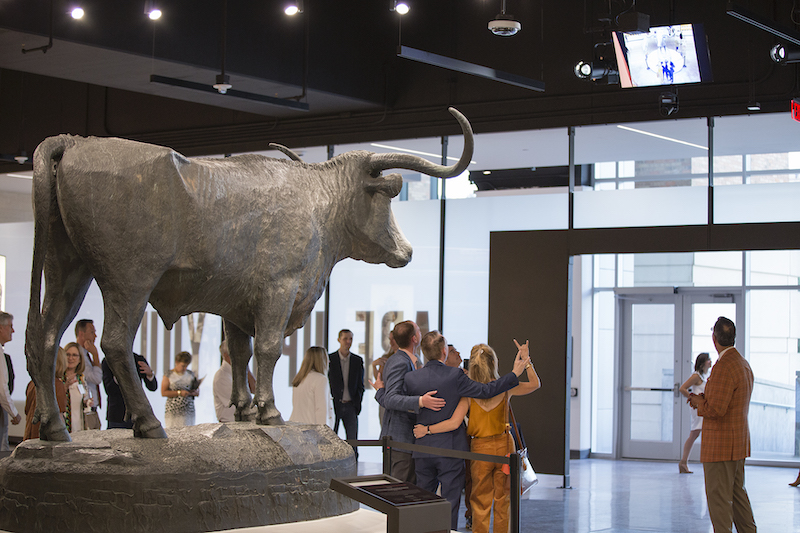Last Friday, the University of Texas at Austin held a grand opening ceremony for the Frank Denius Family Athletics Hall of Fame, a 24,713-sf space that is located at the north endzone of Darrell K. Royal-Texas Memorial Stadium.
The $17.1 million space, designed by Page and built by Turner Construction, includes 392 trophies earned over the decades by the university’s 20 sports teams. Visual and digital displays celebrate UT’s 55 national championship teams, 599 conference team titles, 144 individual national champions, and 171 Olympians who have won 145 medals.
The national champions are highlighted in their own 1,400-sf room with a 16x9-ft monitor that plays videos commemorating team title victories.
Also included in the Hall of Fame is an 8-ft-tall, 1,200-lb statue honoring the school’s mascot, the longhorn Bevo. The Hall of Fame offers a visual timeline of the 15 Bevos in Texas’ history since 1917.
Nashville, Tenn.-based Advent was a co-collaborator on this project, responsible for creating the “stories” that identify special touchstones and moments in the history of UT’s athletic programs.
John Roberson, Advent’s owner, had worked previously with Chris Del Conte, UT’s Athletic Director, when Del Conte held the same post at Texas Christian University. “Chris was brought in as a change agent, to restore the culture” for UT’s athletic program, Roberson tells BD+C.
That culture, he explains, is defined by stories “that are repeated.” Telling those stories required Advent to pull together the school’s trophies and other memorabilia that were scattered all over the place. For example, a Wheaties box that featured UT’s 2005 national championship football team and its legendary coach Mack Brown was found in someone’s garage. Trophies won by the school’s baseball team were located in crates in the basement of the team’s fieldhouse.
It’s not just the trophies that matter, though, says Roberson. “It’s identifying the heroes” and the narratives about individuals, teams, and special moments. Advent helped UT select those people and events using a proprietary process called “story mining,” which Roberson describes as “empathetic listening” to stakeholders. Advent used data analysis software to identify within those captured stories what needed to be told “to uncover the emotions” of the time and place.
“We’re transporting you, taking you back,” says Roberson, via images and interactive exhibits. “Memory is created by the experience that causes wonderment.”

A statue of UT's mascot, the longhorn Bevo, is prominently displayed in the Hall of Fame. Image: Rick Myers/Advent
Darrell K. Royal-Texas Memorial is the ninth-largest stadium in the world, with a seating capacity of 100,119. So, says Roberson, several hundred thousand people could conceivably visit the Hall of Fame during the football team’s season, which opened with a 45-14 win over Louisiana Tech University last Saturday. Roberson expects UT to also use this facility as part of its student recruitment effort, and to lease it out for events like weddings.
He believes the Hall of Fame is a “smart investment” for the university to recapture a space that had been a wide concourse and circulation area with a modest food court.
In conjunction with the opening of the Hall of Fame, UT has entered into a joint branding agreement with the U.S. Olympic and Paralympic Committee in an effort to strengthen Olympic sports programming at the collegiate level. The tagline for the campaign is “Olympians Made Here.”
The Athletics Hall of Fame is named after Frank Denius, an alumnus who passed away in 2018 at the age of 93. Denius was a decorated World War II veteran, having been awarded four Silver Stars and two Purple Hearts. He earned two degrees, in business and law, at UT, and supported the university philanthropically.
Related Stories
Sports and Recreational Facilities | Sep 27, 2017
A soccer team’s fan base could play an integral role in its new stadium’s design and operations
Sacramento Republic FC and HNTB are conducting a contest where the public can submit concept ideas.
Sports and Recreational Facilities | Sep 11, 2017
Mid-size, multi-use arenas setting a trend for the future
While large 20,000-seat sports venues aren’t going away, mid-size venues provide advantages the big arenas do not in a time of budget constraints and the need for flexibility.
AEC Tech | Aug 25, 2017
Software cornucopia: Jacksonville Jaguars’ new practice facility showcases the power of computational design
The project team employed Revit, Rhino, Grasshopper, Kangaroo, and a host of other software applications to design and build this uber-complex sports and entertainment facility.
Sports and Recreational Facilities | Aug 18, 2017
Video: Designing the ideal rugby stadium
HOK invited four world-class rugby players into its London studio to discuss what they would like to see in the rugby stadiums of the future.
Sports and Recreational Facilities | Aug 16, 2017
Detroit Pistons Performance Center hopes to invigorate the community, create an NBA championship team
The facility will be incorporated into the community with public spaces.
Sports and Recreational Facilities | Jul 17, 2017
A new Rec Centre in Toronto links three neighborhoods
Community engagement impacts its design and programming.
Codes and Standards | Jun 21, 2017
Senate bill would prohibit tax money for sports stadium projects
Bipartisan legislation would prevent use of municipal bonds by pro teams.
Building Team Awards | Jun 8, 2017
Team win: Clemson University Allen N. Reeves Football Operations Complex
Silver Award: Clemson gets a new football operations palace, thanks to its building partners’ ability to improvise.
Sports and Recreational Facilities | May 19, 2017
Construction of $2.6 billion L.A. football stadium delayed by heavy rains
The Rams and Chargers won’t be able to move in until the 2020 season.
Sports and Recreational Facilities | Apr 21, 2017
3D printed models bring new economic district in Detroit to life
The centerpiece is the scaled replica of a new arena that puts a miniature fan in every seat.

















